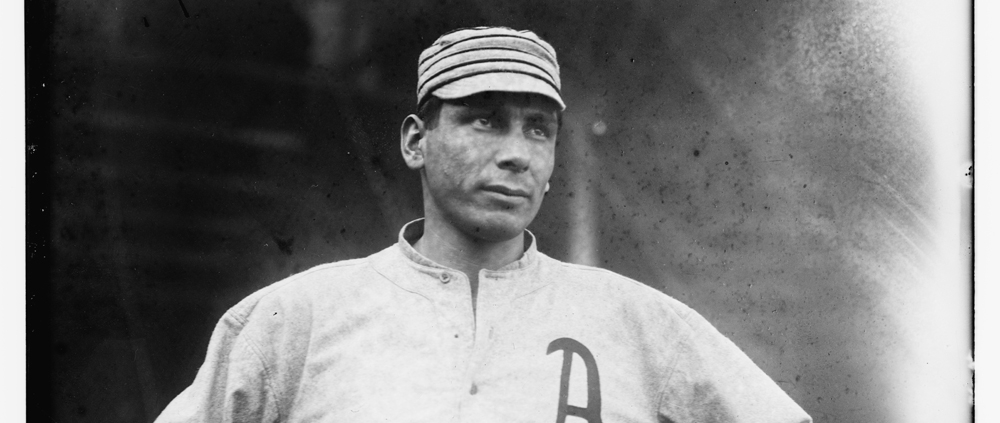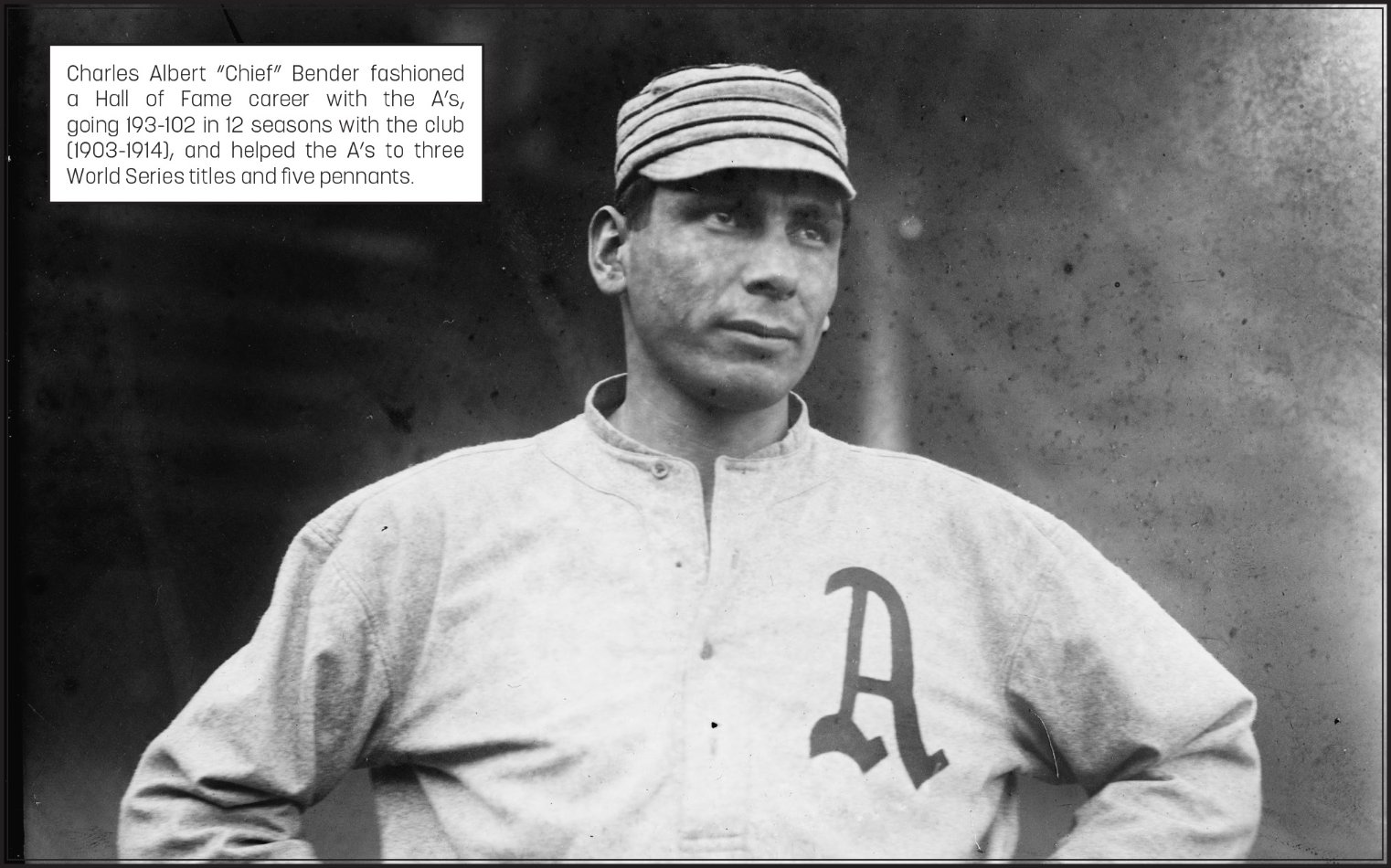May 12, 1910: Charles Bender tosses first no-hitter in Shibe Park history
“Bender’s control, his absolute mastery over the batters and his speed were almost ideal,” gushed the Philadelphia Inquirer about Charles Bender’s no-hitter, the first in the history of Shibe Park.1 Cleveland Naps batters were “Benderized and hypnotized” by the Athletics hurler, opined the Cleveland Plain Dealer, noting in the racially insensitive parlance of the era that Bender “sunk his tomahawk deep into the Naps.2
After finishing in second place in 1909, owner-manager Connie Mack’s A’s exploded out of the gate in 1910, winning 12 of their first 16 games as they prepared for a four-game set against the second-place Naps (12-6) in the City of Brotherly Love. The first two scheduled contests had not produced a winner: In the opener the A’s Cy Morgan battled Addie Joss to a 1-1, 12-inning tie and the second game was rained out. Right-hander Jack Coombs warmed up for the first-place club, ready to make his third start of the season. Just as home-plate umpire Bill Dinneen called for the batterymates, the Tall Tactician, made a sudden and unexpected switch, according to the Cleveland Press, and announced Bender as his starter.3
A 26-year-old right-hander, Bender had the reputation of a cerebral, unflappable hurler. He won 17 games and logged 270 innings as a 19-year-old rookie in 1903 and notched 18 more victories for the AL pennant winners in 1905, highlighted by an overpowering four-hit shutout against Iron Man Joe McGinnity and the New York Giants in Game Two of the World Series. Entering the ’10 season with a stellar 102-71 career slate, Bender’s success was set against the backdrop of the fierce racial prejudice and discrimination he endured on and off the baseball field because of his Native American ancestry. Charles Albert Bender’s mother was part Ojibwa and his father German-American. The young Bender lived on the White Earth Reservation in northern Minnesota, and was later educated in boarding schools, including the Carlisle Indian School in Carlisle, Pennsylvania, which legendary athlete Jim Thorpe had also attended. Bender despised the moniker Chief, and was known for his calm demeanor on the mound despite taunts and violent references to his heritage. Sportswriters typically reduced him to a caricature of Native American culture, a fierce warrior with a tomahawk and headdress.
Coming off an 18-8 campaign with a 1.66 ERA, the stout 6-foot-2, 185-pound Bender began the 1910 season on a roll, tossing four consecutive complete-game victories. He looked to extend that streak on a cool Tuesday afternoon with temperatures in the 50s against the Naps, whose name derived from hitter extraordinaire Nap Lajoie, who had also managed the club until yielding to Deacon McGuire in the middle of the 1909 season. The Naps’ leadoff batter, rookie Jack Graney, lined a “low and savage drive,” according to the Plain Dealer, that looked as if it would fall in for a hit until center fielder Rube Oldring rushed in and made a shoestring catch.4
Oldring’s snare turned out to be the play of the game as the Naps didn’t sniff at another hit all afternoon. The only other cause for excitement occurred in the sixth when right fielder Danny Murphy sprinted to the concrete wall separating the bleachers from the playing field in foul territory to corral Bris Lord’s popup, and then jumped over the wall and up three rows of seats before he could catch his balance.5 Bender’s solitary blemish was a fourth-inning walk to Terry Turner, who was immediately erased attempting to steal.
While Bender mowed down the Naps, the A’s faced 24-year-old southpaw Fred Link (2-1), who burst on the scene after winning 20 or more games in three of his first four seasons in the minors. He debuted by tossing a 10-inning complete-game four-hitter to beat the Detroit Tigers on April 15 and was coming off an 11-inning, three-hit victory against the St. Louis Browns in his last start. In the second inning, Murphy belted a double down the left-field line. Moments later, he was caught a “mile off second” when Link made a quick toss to shortstop Turner, whose muff enabled Murphy to reach third.6 That play epitomized the afternoon for Link and the Naps. Normally a good-fielding team (finishing with the AL’s second highest fielding percentage, behind the A’s), the Naps committed four costly blunders in this contest. Jack Barry’s roller to left drove in Murphy for what proved to be the only run the A’s needed with Bender on the rubber.
In the fourth, Home Run Baker beat out an infield hit to Lajoie at second base. Link’s quick toss to first seemingly caught Baker napping, but his throw sailed and Baker advanced a station. After Harry Davis’s sacrifice bunt, Murphy’s “wicked smash,” which third baseman Bill Bradley “partly batted down,” accounted for the second run.7 It was almost déjà vu in the sixth when the fleet-footed Baker beat out an infield down the first-base line and reached second when Link, covering first, couldn’t hold on to first baseman George Stovall’s throw. Davis’s single plated Baker for a 3-0 lead.
A capable hitter who knocked in 16 runs on 25 hits in 1910, Bender singled in the seventh and scored the A’s fourth and final run, on Topsy Hartsel’s triple.
Breezing through the ninth, Bender retired Lord on a line drive to Hartsel in left field, then fanned Bradley. Elmer Flick, pinch-hitting for Link, popped a “dinky little foul” to catcher Ira Thomas to end the game in 1 hour and 36 minutes.8
Bender faced the minimum 27 batters and fanned four en route to the first no-hitter in the history of Shibe Park, baseball’s first steel and concrete stadium, which opened at the beginning of the previous season; and the first no-no by an A’s pitcher in Philadelphia. It was the second in A’s history, following Weldon Henley’s no-hitter against the St. Louis browns on July 22, 1905.
In his next start, Bender tossed a four-hit shutout against the Chicago White Sox in what unfolded as a career year. He won a personal-best 23 games, completed 25 of 28 starts, and posted a career-low 1.58 ERA in 250 innings. He teamed with Coombs, who emerged as baseball’s best hurler (31-9), to form a staggering duo that led the A’s to their first of four pennants in a five-year stretch that included World Series titles in 1910, 1911, and 1913. Bender went on to win 212 games (127 losses) in his 16-year career and was elected to the Baseball Hall of Fame in 1953.
Sources
In addition to the sources cited in the Notes, the author accessed Retrosheet.org, Baseball-Reference.com, and SABR.org.
Notes
1 “Naps Were Helpless Before Big Injun,” Philadelphia Inquirer,” May 13, 1910: 10.
2 “Even Lajoie Cannot Make Hit Off the Great Chieftain,” Cleveland Plain Dealer,” May 13, 1910: 10.
3 “Big Chief Bender Kept Base Paths Looking as Bare as Abandoned Trail,” Cleveland Press, May 12, 1910: 12.
4 “Even Lajoie Cannot Make Hit Off the Great Chieftain.”
5 “Even Lajoie Cannot Make Hit Off the Great Chieftain.”
6 “Even Lajoie Cannot Make Hit Off the Great Chieftain.”
7 “Even Lajoie Cannot Make Hit Off the Great Chieftain.”
8 “Even Lajoie Cannot Make Hit Off the Great Chieftain.”
Additional Stats
Philadelphia Athletics 5
Cleveland Naps 0
Shibe Park
Philadelphia, PA
Box Score + PBP:
Corrections? Additions?
If you can help us improve this game story, contact us.



